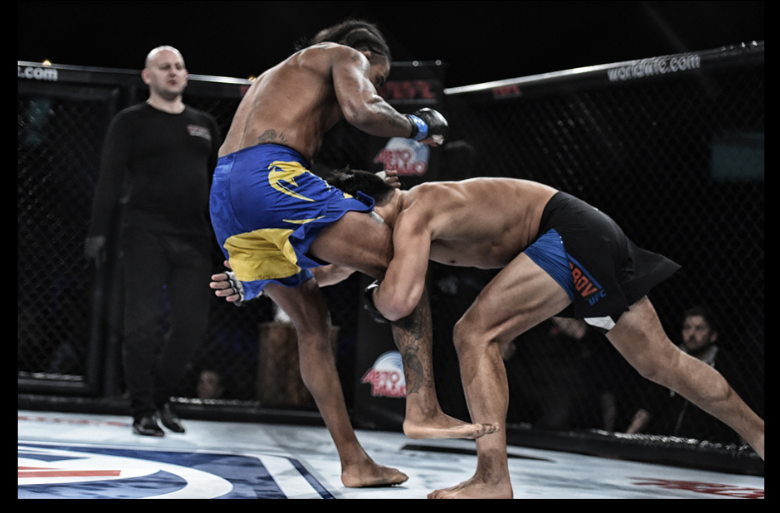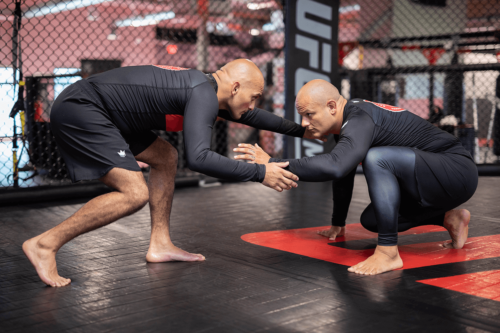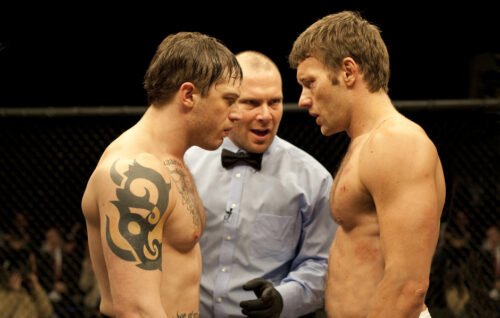Building on our previous post on Mixed Martial Arts, this article introduces newcomers to the sport to some of its intricacies. Are you new to MMA and finding it challenging to grasp some of the fundamental concepts? Look no further!
Introduction
Understanding Mixed Martial Arts (MMA) can be both exhilarating and complex. As a dynamic combat sport that combines various fighting disciplines, MMA demands a grasp of its fundamental rules to fully appreciate the action inside the octagon. In this post, we’ll explore key MMA elements, shedding light on the sport’s intricate intricacies and intense dynamics.Whether you’re new to MMA or a seasoned spectator, our guide aims to provide you with a comprehensive understanding, enabling you to follow the bouts with greater insight and enthusiasm.
In our previous post on MMA we covered the universal rules as well as weight classes. Here we shall look at ways to win and additional insights.
Table of Contents
Fighting Styles
MMA has had a remarkable journey from its early uni-disciplinary beginnings into today’s dynamic and multifaceted sport. In its inception, fighters often specialised in a single discipline such as boxing, wrestling, or Brazilian Jiu-Jitsu. This lead to distinct styles clashing in the cage. Over the years, the sport transformed as athletes realized the need for greater versatility to achieve success. Strikers did not want to be at a disadvantage on the floor rolling with grapplers. Likewise, grapplers saw the need to improve their stand up game. As a result, fighters have pursued cross-training. Combining various martial arts disciplines to develop comprehensive skill sets that include striking, grappling, and takedowns.
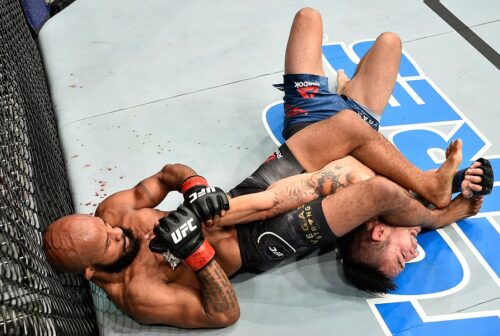
In MMA, sticking with a single skill set, regardless of a fighters background, isn’t enough for success. To thrive, fighters must continuously learn and incorporate new skills to remain versatile and competitive.
While fighters are now more versatile and capable of adapting to different scenarios, they often tend to specialise in particular areas. Some excel as striking specialists, leveraging techniques from boxing, Muay Thai, or kickboxing. Others embrace grappling and submission skills honed through Brazilian Jiu-Jitsu or wrestling backgrounds. This amalgamation of techniques and strategies has elevated MMA to new heights. It has resulted in fighters who can seamlessly transition between different aspects of combat. This has made the sport an intricate display of skill, strategy, and adaptability.
Types of Fighter
In MMA, fighters can be categorised into various types based on their fighting style, strengths, and strategies. Here are some common types of fighters:
Common types of fighters:
Click on the links below for brief explanation of MMA fighting styles.
Striker:
Strikers are skilled in stand-up fighting, focusing on striking techniques such as punches, kicks, elbows, and knees. They aim to keep the fight on the feet and use their striking prowess to deal damage and potentially secure knockouts.
Examples: Israel Adesanya. Conor McGregor. Anderson Silva.
Grappler:
Grapplers are adept at ground-based techniques such as takedowns, submissions, and control. They often aim to take the fight to the ground and work for dominant positions or submissions.
Examples: Demian Maia. Royce Gracie. Frank Mir.
Wrestler:
Wrestlers have a strong background in wrestling and are skilled in takedowns, takedown defence, and controlling opponents on the ground. They use their wrestling skills to dictate where the fight takes place.
Examples: Daniel Cormier. Khabib Nurmagomedov. Kamaru Usman.
Jiu-Jitsu Specialist:
These fighters excel in Brazilian Jiu-Jitsu (BJJ) and are known for their expertise in ground submissions and positional control. They look to take the fight to the ground and work for submissions.
Examples: Royce Gracie. Demian Maia. Fabricio Werdum.
All-Rounder:
All-rounders are well-rounded fighters who have a balanced skill set in striking, grappling, and submissions. They can adapt their strategy based on their opponent’s weaknesses.
Examples: Jon Jones. Amanda Nunes. Demetrious Johnson.
Counter-Striker:
Counter-strikers are patient fighters who focus on evading their opponent’s attacks and waiting for opportunities to counter with precise strikes.
Examples: Israel Adesanya. Conor McGregor. Anderson Silva.
Pressure Fighter:
Pressure fighters maintain constant forward movement and aggressive tactics, aiming to overwhelm their opponents with strikes, clinches, and takedowns.
Examples: Max Holloway. Justin Gaethje. Khabib Nurmagomedov.
Swarmers:
Swarmers are fighters who apply high-paced, aggressive pressure by throwing a high volume of strikes and overwhelming opponents with their intensity.
Examples: Nate Diaz. Clay Guida. Diego Sanchez.
Clinch Specialist:
These fighters excel in close-quarters grappling and clinching against the cage, where they can deliver strikes, control, or work for takedowns.
Examples: Anderson Silva. Jon Jones. Petr Yan.
Striking Wrestler:
Combining striking skills with wrestling proficiency, these fighters can dictate the range of the fight and mix takedowns with striking combinations.
Examples: Kamaru Usman. Islam Makhachev. Khabib Nurmagomedov.
Counter-Grapple Specialist:
These fighters are skilled at defending takedowns and grappling attempts, using their takedown defence to keep the fight standing where they can showcase their striking skills.
Examples: Dominick Cruz. Lyoto Machida. Anderson Silva.
Brawler:
Known for their aggressive, high-energy fighting style, often characterized by a willingness to engage in wild exchanges and slugfests with opponents. Brawlers are known for their durability, tenacity, and the ability to absorb punishment while delivering powerful strikes. They may not always rely on refined technique but instead focus on overwhelming their opponents with relentless forward pressure and striking power. Brawlers aim to create exciting and entertaining fights, often becoming fan favorites for their thrilling and action-packed performances.
Examples: Justin Gaethje. Nate Diaz. Chan Sung Jung (The Korean Zombie).
Cardio King/Queen:
In MMA this refers to a fighter who possesses exceptional cardiovascular endurance and stamina. These fighters are known for their ability to maintain a high level of activity and intensity throughout the duration of a fight. They can push the pace, recover quickly between rounds, and often outlast their opponents, even in grueling, extended battles. Cardio kings and queens are admired for their exceptional conditioning, which allows them to perform at their best for the entire fight, making them formidable competitors in the world of mixed martial arts.
Examples: Alexander Volkanovski. Nate Diaz. Kamaru Usman.
It’s important to note that most fighters are versatile and can adapt their strategies based on their opponent’s strengths and weaknesses. These categories provide a general framework for understanding fighting styles, but individual fighters often bring unique elements to their approach.
Fighters from many backgrounds
The diverse backgrounds from which MMA fighters emerge contribute to the sport’s dynamic nature. With athletes joining from disciplines like boxing, wrestling, judo, Brazilian Jiu-Jitsu, Muay Thai, and beyond, the octagon becomes a canvas on which various techniques blend, creating a captivating fusion of combat styles. This diversity extends beyond martial arts backgrounds, as fighters with backgrounds in other sports also find their place in MMA. The resulting mix not only showcases the adaptability and innovation of fighters but also keeps the sport in a state of perpetual evolution. With a global presence, MMA draws fighters from all corners of the world, each bringing their unique cultural influences and approaches. This amalgamation of styles ensures that MMA remains an ever-evolving spectacle, captivating audiences worldwide and propelling fighters to constantly push their boundaries.
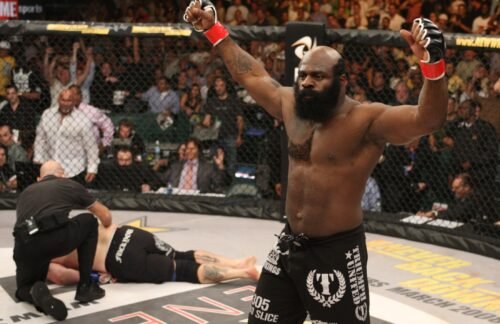
Fighters come from all manner of backgrounds. The legendary Kimbo Slice (real name was Kevin Ferguson) gained fame as a street-fighting sensation on YouTube before transitioning to professional MMA.
Fight Camps
Fight camps are intensive training periods where MMA fighters dedicate weeks to refining their skills and preparing for upcoming bouts. These camps involve a comprehensive approach that encompasses technical development, conditioning, strategy formulation, and mental preparation. Fighters collaborate closely with their coaches to analyse opponents’ strengths and weaknesses, developing game plans tailored to exploit favourable matchups. Intense sparring sessions and technical drills help fighters fine-tune their striking, grappling, and submission techniques, while strength and conditioning regimens enhance their physical fitness and endurance. Moreover, mental conditioning and visualisation techniques play a pivotal role in building mental resilience and focus, crucial for maintaining composure inside the cage.
Fight camps in MMA are intense training programs where fighters prepare physically and mentally for upcoming bouts, refining their skills and strategies.
Coaches and Training Partners
In these camps, coaches assume a pivotal role as mentors, strategists, and technical guides. They provide expert guidance, ensuring that fighters are progressing in their skill sets and shaping their training regimen to match the opponent’s tendencies. Coaches also serve as motivators, offering encouragement and mental support to maintain the fighter’s confidence and focus. Training partners, who simulate different opponents, contribute immensely to a fighter’s development. They help recreate real-fight scenarios during sparring and drilling sessions, offering a variety of challenges that prepare fighters to adapt swiftly and effectively. These partners play a critical role in refining techniques, testing strategies, and bolstering fighters’ overall readiness for the upcoming battle. Ultimately, the collaborative effort of coaches and training partners during fight camps is central to the fighter’s success on fight night, ensuring they step into the octagon with the confidence, skills, and strategic acumen needed to emerge victorious.
The Combat Arena

MMA bouts take place on a raised platform in cages (above) or traditional fight rings with ropes. The choice of cage or ring design can vary based on the promotion’s preferences and regional regulations. Both the UFC and Bellator use an Octagon shaped cage. ONE Championship (uses a circular cage) whilst RIZIN Fighting Federation (uses a square ring). Regardless, the combat arena is an environment that can be used and exploited by fighters depending on their strengths and weaknesses.
Exploiting the battleground
MMA fighters will leverage the cage to their full advantage. Depending on the fighting style of a particular fighter, they will try to pressure or keep their opponents into areas where they have the upper hand. Understanding these strategic nuances enriches the viewing experience, providing insights into the chess match that unfolds within the MMA cage.
Click on the links below for brief explanation of how MMA use certain areas of the cage to their advantage.
Centre:
The centre of the octagon is often considered neutral ground. Fighters can move freely and have equal access to striking and grappling opportunities. Being in the center allows fighters to control the pace and direction of the fight.
Against the Cage:
This is often referred to as the “clinch” or “cage control” position. Fighters can press their opponent against the cage to limit their movement, deliver short strikes, and attempt takedowns or throws. This can be favourable for wrestlers (looking to secure a takedown); close range fighters; It can also be useful to fighters trying to defend from takedowns (although its illegal to grab the fence).
Range:
Fighters can stay at a distance from each other in the striking range. Here, they can exchange punches, kicks, and other strikes, while also working on footwork to create angles and avoid being hit.
Close Range:
In close quarters, fighters can engage in dirty boxing or Muay Thai style techniques. Here they may use short strikes such as elbows, knees and short punches. This range is also conducive to clinching and takedown attempts.
Ground:
When a takedown is successful, the fight can move to the ground. Fighters work for positions, ground-and-pound strikes, and submission attempts. Different positions like guard, mount, side control, and back control offer various offensive and defensive options.
Fence/Gate:
The area closest to the cage can limit movement and provide opportunities for takedowns, control, and clinching. Fighters might use the fence to prevent opponents from circling away.
Corner:
Each fighter’s corner provides a brief resting point between rounds and a place for receiving instructions and advice from coaches.
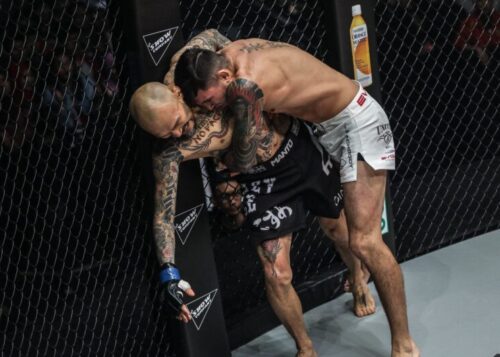
(Above: Clinching against the cage in MMA is a tactical advantage, enabling fighters to control their opponents, limit striking opportunities, and set up takedowns or position changes). Fighters strategically navigate areas of the cage to capitalise on their strengths and exploit their opponent’s weaknesses. Effective octagon control involves understanding when to engage or disengage, controlling the centre, and utilising different areas to execute one’s game plan.
Combat Strategies
Striking Strategies:
Striking techniques are a cornerstone of Mixed Martial Arts, providing fighters with an array of tools to attack and defend. MMA striking encompasses a wide range of techniques borrowed from various striking disciplines, including Boxing, Muay Thai, Karate, and Kickboxing. Fighters utilize punches, kicks, elbows, knees, and even spinning attacks to create openings and inflict damage on their opponents. Precision, timing, and versatility are paramount in MMA striking, as fighters must adapt to the ever-changing dynamics of a bout, which can transition from stand-up exchanges to ground and clinch situations. Effective striking requires a combination of skills, including crisp footwork, head movement, and a strong defensive guard. Striking in MMA is not only about power but also about strategy, feints, and setting up takedowns or submission attempts, making it a multifaceted aspect of this dynamic combat sport.

Striking in MMA combines various martial arts disciplines, including boxing, Muay Thai, and kickboxing, to deliver powerful punches, kicks, elbows, and knees, making it a dynamic and integral aspect of the sport.
Level Changes:
In Mixed Martial Arts, ‘level changes’ refer to a strategic movement technique used by fighters to alter their positioning and attack their opponents. It involves changing the vertical height or level at which a fighter presents themselves to their opponent. This technique is typically used to set up takedowns, strikes, or defensive maneuvers. Level changes can be sudden and deceptive, making it difficult for opponents to anticipate the fighter’s next move.
For example, a fighter may start by standing tall, then suddenly drop their level by bending their knees and hips, bringing their upper body closer to the ground. This can serve various purposes:
Takedowns:
Fighters often use level changes to initiate takedowns, lowering their level to secure a better position to grab their opponent’s legs or waist.
Setting up strikes/creating angles:
Level changes can also be employed to set up strikes. By dropping their level, a fighter can create angles for punches or kicks, making it challenging for their opponent to defend or counter effectively.
Defensive Maneuvers:
Fighters may use level changes defensively to avoid strikes or takedowns from their opponents. By changing levels quickly, they can slip out of the path of an incoming attack.
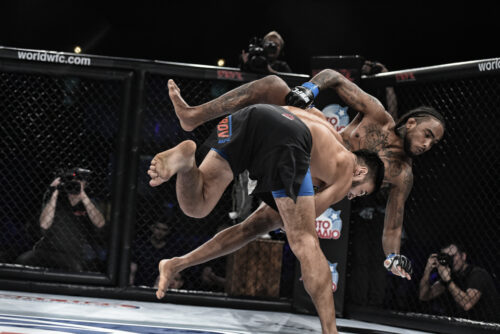
Level changes are an essential part of a fighter’s arsenal, adding versatility and unpredictability to their overall strategy. Properly executed level changes can help fighters gain a significant advantage in MMA bouts, whether they’re looking to secure a takedown, land a devastating strike, or evade their opponent’s offense.
Defensive Strategies:
Defensive techniques play a crucial role in MMA (Mixed Martial Arts), where fighters need to protect themselves from a wide array of striking and grappling attacks. MMA defensive techniques include blocking, parrying, evasive head movement, and clinching to minimize damage from strikes. Fighters also use footwork and distance management to avoid incoming blows and create opportunities to counterattack. On the ground, defensive techniques involve establishing a guard, preventing passes, and escaping submissions. MMA fighters must maintain a high level of situational awareness to anticipate their opponent’s moves and react defensively, all while being ready to transition between different phases of the fight. A strong defensive foundation is essential for a fighter’s longevity and success in the sport, as it allows them to weather storms, avoid taking unnecessary damage, and stay competitive throughout the bout.

Effective defense in MMA involves a combination of techniques, including blocking strikes, evading takedowns, and using grappling skills to prevent submissions or escapes, providing fighters with a crucial advantage in the cage.
Other Strategies:
Fighters and coaches create detailed game plans for each opponent. This includes studying their opponent’s strengths and weaknesses, developing strategies to exploit vulnerabilities, and simulating fight scenarios in training.
Click on the links below for brief explanation of strategies MMA fighters will use.
Watching the Clock
Clock watching in MMA refers to the strategic management of time during a fight. Fighters and their coaches closely monitor the round and overall fight time to make informed decisions. As the clock counts down, fighters adjust their tactics based on the situation. For instance, if a fighter is ahead on points, they might prioritize defense and avoid unnecessary risks to secure a victory. Conversely, if they’re trailing, they may become more aggressive, seeking opportunities for a knockout or submission. Clock watching also plays a crucial role in pacing a fight, as fighters aim to conserve energy early on, then ramp up their efforts when necessary, all while being mindful of the remaining time. It’s a skill that combines fight IQ, situational awareness, and the ability to adapt to ever-changing circumstances, making it an integral part of MMA strategy.
Distance Control:
Distance control is fundamental in MMA. Fighters use footwork to maintain an advantageous range. For strikers, controlling the distance means staying just outside the opponent’s striking range. This involves using precise footwork to circle, pivot, and create angles that make it difficult for the opponent to land significant strikes. Fighters with longer reach may use their jab to keep the opponent at bay, while others may employ kicks to maintain distance. Conversely, grapplers often seek to close the distance to get in tight with their opponents. By pressing the action and clinching, they can initiate takedowns or utilize their grappling skills. Footwork here is crucial as well, but it’s geared towards closing the gap and establishing control inside the clinch. The mastery of distance control allows fighters to dictate the pace of the fight and play to their strengths, whether that’s striking, grappling, or a combination of both. It’s a chess match in which each fighter aims to maintain the range that best suits their strategy while disrupting their opponent’s game plan.
Feints and Deception:
Feints and deception are tactics used in MMA to confuse opponents, create openings, and gain a mental edge. Fighters employ simulated attacks (feints) and unpredictable movements to draw reactions, disrupt opponents’ rhythm, and plant doubt. These tactics are integrated into their strategic planning, allowing them to set traps and control the fight’s pace. Successful use of feints and deception can lead to openings for strikes or takedowns and create psychological advantages over opponents.
Strategic Rest:
Strategic rest is a vital tactic employed by MMA fighters to recover energy while maintaining control and minimizing damage. They often use cage control or clinch work to create a momentary pause in the action, limiting their opponent’s striking opportunities and giving themselves a chance to catch their breath. During this respite, fighters focus on controlled breathing, strategically timing these breaks to avoid vulnerability. They may also use this time to assess their opponent’s movements and plan counterattacks. This calculated approach showcases a fighter’s ability to manage their resources effectively, making tactical decisions that impact the fight’s outcome.
Cage or Ring Control:
Fighters who understand how to use the cage or ring to their advantage can control the pace of the fight and limit their opponent’s movement. (See above – The Combat Arena).
Adaptation:
Adaptation is a critical skill in MMA, enabling fighters to adjust their strategy on the fly during a bout. It involves assessing the opponent’s tactics, making in-fight assessments, and strategically changing approaches based on what’s working and what’s not. Adaptation covers both offense and defense, as fighters must respond to their opponent’s strengths and weaknesses. Coaches and corners provide guidance, and mental toughness plays a role in staying composed under pressure. Adaptation also means capitalizing on opportunities and having a high fight IQ to make intelligent decisions in real time. It’s a vital aspect of MMA that can determine a fighter’s success inside the cage.
Strategic Risk-Taking:
In MMA, strategic risk-taking is a pivotal element of a fighter’s game plan. It involves making calculated decisions to capitalize on key opportunities for a knockout or submission. These opportunities hinge on factors like assessing the fight’s progress, timing, and understanding their opponent’s vulnerabilities. Fighters rely on their fight IQ, recognizing patterns, and using setups like feints or combinations. They consider the clock, their energy levels, and the potential consequences of their high-risk moves. Coaches provide guidance, and fighters adapt when needed. Strategic risk-taking often leads to the sport’s most memorable moments, as fighters seize the chance to secure victory in thrilling fashion.
Psychological Warfare:
Psychological warfare in MMA involves fighters using tactics like trash talk, intimidation, and mind games to gain a mental edge. They engage in verbal exchanges to unsettle opponents and disrupt their focus. Physical intimidation through aggressive body language and staredowns can make opponents doubt their abilities. Fighters also employ mind games, feints, and psychological tactics during bouts. On the flip side, they focus on mental toughness, emotional control, and mental preparation to stay composed under pressure. While psychological warfare adds intrigue to MMA, it’s not always a guaranteed path to victory, as a fighter’s mental strength and preparation are crucial in this physically demanding sport.

Chael Sonnen’s mastery of ring psychology and ability to get under opponents’ skin were key factors in his success, often leaving his adversaries emotionally rattled before the fight even began.
Stances:
The stance in MMA distinguishes itself from that in Boxing or Muay Thai due to the sport’s unique blend of striking and grappling disciplines. MMA fighters maintain a more versatile stance to seamlessly transition between these diverse techniques. Unlike boxing or Muay Thai, where the focus is predominantly on punches or specific striking techniques, MMA demands a broader skill set. Fighters in MMA often keep their guard slightly lower to facilitate swift defense against takedowns and grappling, with a wider stance that provides better balance and stability. Their weight distribution is more evenly spread between the lead and rear legs, enabling quick shifts for striking and takedown defense. Mobility and footwork are prioritized to evade takedowns or engage on the ground, making the MMA stance a critical element in this multifaceted combat sport.

Some MMA fighters deviate from the ‘traditional’ MMA stance and opt for something more unorthodox. Newly crowned Middleweight champion Sean Strickland (left) adopts a ‘Philly shell’ style stance straight out of boxing. Stephen ‘Wonderboy’ Thompson (right) opts for an open karate style stance.
Unorthodox Stances:
However, within the framework of MMA’s versatile stance, fighters often personalize their positions to suit their individual styles and preferences. Some may opt for a more boxing-centric stance, emphasizing precise striking and head movement, while others might incorporate elements from Muay Thai or Karate to leverage kicks and clinching techniques. This adaptability allows fighters to express their unique strengths and strategies within the broader context of MMA, adding an extra layer of complexity to the sport’s ever-evolving dynamics.
Taking it to the Ground
Takedowns are vital in MMA, shifting the fight from standing to the ground. Here, fighters employ their grappling skills for submissions or ground-and-pound. Ground positions determine control, enabling dominant positions. Fighters target submissions like joint locks and chokes. Ground-and-pound inflicts damage, often leading to referee stoppages. Takedowns also score points with judges, showcasing control and dominance. In short, takedowns are central to MMA, shaping the fight’s outcome through ground strategies, scoring, and offensive opportunities.

Takedown techniques require a combination of timing, positioning, and leverage. Fighters often use their opponent’s movements and reactions to set up and execute them effectively.
Common types of takedowns:
Click on the links below for brief explanation of MMA takedowns.
Double Leg Takedown:
The double leg is a basic yet effective takedown. The fighter shoots in on their opponent, driving through the opponent’s legs with their shoulders while wrapping their arms around both legs. This takedown aims to lift and bring the opponent to the ground.
Single Leg Takedown:
Similar to the double leg, the fighter targets one of the opponent’s legs. They secure the leg, often by wrapping both arms around it, and then drive forward, off-balancing the opponent to bring them down.
High Crotch (Inside or Outside):
The high crotch takedown involves controlling one of the opponent’s legs by reaching across their body and securing the leg at the hip or upper thigh level. The fighter then lifts and drives the opponent off their base to complete the takedown.
Foot Sweep:
This takedown technique involves using one’s leg to hook or sweep the opponent’s leg, causing them to lose balance and fall to the ground. Foot sweeps are often used in clinch situations against the cage.
Body Lock Takedown:
The fighter wraps their arms around the opponent’s torso, creating a “body lock.” They then lift and trip the opponent’s legs, taking them down to the ground.
Suplex:
A suplex is a powerful and dramatic takedown where the fighter lifts the opponent off the ground and slams them onto the mat. It requires significant strength and control.
Judo Throws:
Fighters with a background in judo often use throws like the hip toss, shoulder throw, and harai goshi to off-balance their opponents and take them down.
Trip Takedowns:
These takedowns involve using footwork and leverage to trip the opponent’s legs, causing them to fall. Common trips include the inside trip and outside trip.
Shoot Takedown:
In a shoot takedown, the fighter quickly closes the distance and dives at the opponent’s legs to secure a takedown. It’s a rapid movement that requires timing and precision.
Single Leg X-Guard:
A more advanced takedown, the fighter uses the X-guard position to off-balance the opponent and then transitions to taking them down.

Various Takedown Techniques.
Ground Fighting
In MMA, once a fight goes to the floor, combat arts that emphasize ground control, submission grappling, and defensive skills become incredibly useful. Brazilian Jiu-Jitsu (BJJ): BJJ is one of the most essential combat arts for ground fighting in MMA. It focuses on controlling opponents on the ground, seeking advantageous positions, and applying submissions. BJJ practitioners are skilled at ‘passing the guard’ (getting past an opponent’s legs on the ground) and achieving advantageous positions (such as mount or back control). This allows them to finish fights with joint locks and chokes.
Common ground related positions found in MMA:
MMA offers a variety of positions that practitioners use to control and dominate opponents. Click on the links below for brief explanation of individual positions.
Guard:
The guard position remains a valuable option for a downed fighter in MMA because it offers defensive capabilities and opportunities for offense. From the guard, a fighter on their back can control their opponent’s posture, minimizing the damage from strikes, and look for submission opportunities like triangles, armbars, or sweeps to reverse the position. It allows them to stay active and potentially turn the fight in their favor, making it a strategic and versatile position despite being on the bottom. There are three types of guard positions:
Closed Guard: The bottom fighter’s legs are wrapped around the top fighter’s torso, providing control and opportunities for sweeps and submissions.
Open Guard: The bottom fighter’s legs are used to control the top fighter while creating space for attacks or sweeps.
Half Guard: One of the bottom fighter’s legs is controlled by the top fighter, while the other leg is free. The bottom fighter can work for sweeps or transitions.
Passing the Guard:
“Passing the guard” is a pivotal concept in BJJ (and MMA by extension) involving the strategic maneuvering around an opponent’s legs when they are on their back. It holds significance due to its ability to establish control, score points, and avoid submission threats, crucial in MMA judging criteria. Passing the guard opens up opportunities for effective ground and pound striking and facilitates advancement to dominant positions like side control or mount, where fighters can finish with submissions or strikes. Guard-passing techniques, such as leg drags, knee cuts, and stack passes, are fundamental for MMA fighters, shaping their ground game and contributing to their overall success in the sport.
Half Guard:
Half guard is a ground fighting position in martial arts, including Brazilian Jiu-Jitsu and MMA, where one fighter has their legs wrapped around one of their opponent’s legs while lying on their side. It’s considered a transitional position between being on the bottom in full guard and having full control from a top position. Half guard offers both defensive options and opportunities for sweeps, reversals, and submissions, making it a versatile and strategic position in ground fighting.
Side Control:
The top fighter is perpendicular to the opponent, pinning them to the ground. This is a transitional position that offers control and opportunities for submissions.
North-South:
The top fighter is positioned perpendicular to the opponent’s head, with their chest near the opponent’s head and hips near the opponent’s legs. This position can lead to transitions and submissions.
Mount:
The top fighter sits on their opponent’s chest with their knees pinning the opponent’s arms. This is a dominant position where the top fighter has good control and can deliver strikes or look for submissions.
Back Mount:
The top fighter is behind the opponent and has their hooks (legs) secured around the opponent’s hips. This position provides control and the opportunity to work for a rear-naked choke or other submissions. This is considered a dangerous position for the defender in both BJJ and MMA.
Mount Escapes:
These are techniques used by the bottom fighter to escape from the mount position and regain a more advantageous position.
Back Escapes:
Techniques to escape from a back mount position and prevent submission attempts.
Sprawl
A sprawl is a defensive technique used to counter an opponent’s takedown attempt, typically a single-leg or double-leg takedown. When an opponent shoots in for a takedown and tries to grab one or both of a fighter’s legs, the defender executes a sprawl by sprawling their legs backward while simultaneously sprawling their hips forward. This action helps the defender maintain their balance and prevent the opponent from securing the takedown. A well-executed sprawl can leave the opponent vulnerable and open to counterattacks, allowing the defender to stay on their feet and potentially gain a dominant position. Sprawling is an essential skill in MMA to defend against takedowns and maintain control during a fight.
Ground and Pound
Ground and pound is a common tactic in mixed martial arts (MMA) where a fighter, typically in a top position, uses a combination of strikes, often punches and elbows, to attack their opponent who is on the ground. This strategy aims to inflict damage, weaken, or incapacitate the opponent, ultimately leading to a potential knockout or submission victory. Ground and pound is a versatile technique that requires a fighter to maintain control over their grounded opponent while delivering powerful and accurate strikes, making it a crucial aspect of MMA’s multidimensional combat.
Submission Attempts:
Submissions in MMA are techniques used to force an opponent to give up by putting them in a position of extreme discomfort or risk of injury. These moves typically involve joint locks or chokeholds that, when applied correctly, lead to a tap-out or the referee stopping the fight to prevent injury. (For more on submissions see below).


These are just a few of the many BJJ positions and variations. Understanding these positions is crucial for effective ground control, transitions, and submission attempts in Brazilian Jiu-Jitsu.
For a better understanding of basic BJJ concepts check out our posts covering the art here.
Submissions
Submissions are a critical component of MMA. These attempts are aimed at exploiting an opponent’s vulnerability by applying joint locks, strangles, or other grappling techniques to the point of inflicting pain or risking injury. The primary goal of a submission attempt is to secure a submission victory by making the opponent concede defeat (tap out) to prevent injury or loss of consciousness. MMA fighters draw from Brazilian Jiu-Jitsu, Judo, and submission wrestling to employ these techniques effectively. Submissions encompass a wide range of techniques, including armlocks, leglocks, and various types of chokes such as rear-naked chokes and guillotine chokes. A fighter’s ability to execute submissions and defend against them is a key factor in determining their success in the cage.
Common submissions used in MMA:
Click on the links below for brief explanation of individual submissions.
Rear Naked Choke
This is one of the most iconic submissions in MMA, where a fighter wraps their arm around their opponent’s neck and applies pressure to cut off the blood supply to the brain.
Guillotine Choke:
In a guillotine choke, a fighter traps their opponent’s head and neck between their arms, applying pressure to the throat to force a submission.
Triangle Choke
In this submission, a fighter uses their legs to create a triangle shape around their opponent’s head and arm, squeezing to cut off blood flow and air supply.
Armbar:
A fighter extends their opponent’s arm straight while controlling the wrist and applying pressure on the elbow joint, potentially causing injury or submission.
Kneebar:
A submission that hyperextends the opponent’s knee joint, potentially causing injury or forcing them to submit.
Kimura:
This submission targets the shoulder joint, with a fighter applying pressure to their opponent’s arm while controlling the wrist.
Heelhook:
This is a lower-body submission that targets the heel and ankle, with the goal of causing pain or injury to force the opponent to tap.
D'Arce Choke:
In this choke, a fighter threads their arm under their opponent’s armpit and across their neck, creating pressure on the carotid arteries.

Popular submission used in MMA.
Other Groundfighting arts
Alongside BJJ, other combat arts and skills are valuable when an MMA fight goes to the ground. A fighter skilled in wrestling, Judo, Sambo, submission wrestling, striking techniques, and defensive skills forms a well-rounded skill set for fighters to excel in ground fighting situations in MMA. Successful MMA fighters often integrate these disciplines to adapt to different scenarios and opponents during their matches.
Ways to Win
In MMA, matches can be won in several ways, reflecting the diverse nature of the sport. Here’s an overview of the various methods through which fighters can secure victory:

The thrill of MMA lies in those satisfying moments when fighters deliver decisive KO or submission wins. For fighters, it’s the culmination of their hard work, and for fans, it’s the ultimate payoff, showcasing the raw power and technique that define this dynamic sport.
Click on the links below for brief explanation of ways an MMA fight can end.
Knockout (KO):
A knockout occurs when a fighter delivers a strike that renders their opponent unconscious or unable to continue. This typically happens through powerful punches, kicks, elbows, or knees that incapacitate the opponent.
Technical Knockout (TKO):
A technical knockout happens when the referee determines that a fighter is no longer able to intelligently defend themselves or is taking excessive damage. This can occur due to a series of strikes or a fighter’s inability to respond effectively.
Submission:
A fighter wins by submission when they force their opponent to give up by applying a joint lock or a chokehold. The opponent either taps the mat, verbally submits, or the referee intervenes when the fighter is in danger of injury or unconsciousness.
Decision:
If a fight goes the distance without a knockout or submission, judges score the bout based on effective striking, grappling, octagon control, and aggression. The fighter with the most points from the judges wins a unanimous, split, or majority decision.
Technical Decision:
If a fight ends due to an accidental injury or clash of heads and goes to the scorecards, a technical decision is determined based on the score up to that point.
Disqualification (DQ):
A fighter can be disqualified for committing fouls that are deemed intentional or dangerous, resulting in an immediate loss.
Forfeit:
If a fighter fails to compete, is unable to continue, or is disqualified before the fight, their opponent wins by forfeit.
No Contest (NC):
A no contest occurs when a fight is stopped due to an accidental injury or other circumstances that prevent the bout from continuing, often leaving both fighters without a clear win or loss.
Doctor Stoppage:
If a fighter sustains an injury that is deemed too severe by the ringside doctor, the fight may be stopped, resulting in a win for the opponent.
Corner Stoppage:
In between rounds, a fighter’s corner may decide to throw in the towel or inform the referee that their fighter cannot continue due to injury or exhaustion.
To the Judges
When an MMA fight reaches its conclusion without a knockout or submission, the outcome rests in the hands of the judges. Judges base their decisions on several key factors when scoring an MMA fight:
Click on the links below for brief explanation of factors judges take into consideration when scoring fights.
Effective Striking:
Judges consider the quality, accuracy, and impact of strikes thrown by each fighter. Significant strikes, such as clean punches, kicks, and elbows that land successfully, are weighted more heavily.
Grappling and Takedowns:
The effectiveness of takedowns, takedown defence, control on the ground, and submission attempts play a role in scoring. Dominance and control during grappling exchanges can influence judges’ opinions.
Octagon Control:
This refers to a fighter’s ability to dictate the pace, positioning, and movement within the octagon. A fighter who controls the centre of the octagon and imposes their game plan often gains favour from the judges.
Aggression:
Judges take into account a fighter’s forward movement, engagement, and willingness to engage in striking and grappling exchanges. Aggression, within reason, can score points.
Defence and Counterattacks:
A fighter’s ability to avoid their opponent’s strikes, takedowns, and submission attempts is also considered. Effective defensive techniques, such as blocking, evading, and countering, can sway judges’ opinions.
Damage and Impact:
Visible damage inflicted on an opponent, such as cuts, swelling, and knockdowns, can influence judges’ perceptions of the round’s outcome.
Controlled Aggression:
Judges appreciate a balance between being aggressive and maintaining control. Reckless aggression without effective execution might not receive as much credit.
Submission Attempts and Escapes:
Fighters who attempt submissions or exhibit solid defence against submission attempts demonstrate their grappling skills, which judges consider in their scoring.
Note: It’s important to note that different judges might emphasise certain factors more than others, and their personal interpretation can lead to varied scoring. Additionally, judges aim to remain impartial and focus on the action in the cage, rather than crowd reactions or external influences.

MMA fighters know that leaving a fight in the judges’ hands is like rolling the dice – a risky gamble that may not always favor them. They aim for decisive victories in the cage!
Final Note
In the fast-paced world of MMA, it’s all too easy to miss the action, especially if you are new to the sport. A flurry of blows or a submission pulled out of nowhere and it’s all over. As fights progress rapidly, intricate transitions, strategic feints, and skillful techniques can often be missed with just a single glance. This guide aims to equip you to appreciate some of the nuances, strategies, and the sheer athleticism that make MMA so captivating. Whether you’re watching alongside the excitement of live broadcasts, enjoying replays, or listening to the insightful commentary, you’ll find that your MMA viewing experience is greatly enhanced when you can decipher the multifaceted action inside the cage. So explore the techniques, strategies, and the heart-pounding intensity of MMA, and elevate your appreciation for this thrilling combat sport.

If you have enjoyed this post please share or feel free to comment below 🙂
Related Posts
Other Posts

Kettlebell Wrath
Mission Briefing Welcome to Kettlebell Wrath, the first in our series of Kettlebell Commando Raids.Brutal



Wednesday AMRAP
Push yourself with our Wednesday AMRAP workout. Calisthenics-based total body circuit that will burn calories

Conan the Barbarian Workout
Welcome to our Conan the Barbarian workouts. Strongman circuits to test strength, stamina and willpower.


